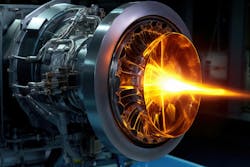BAE Systems to design extreme-temperature pressure sensor for hypersonic aircraft and inside jet engines
NASHUA, N.H. – U.S. military researchers are asking BAE Systems to develop a high-bandwidth pressure sensor for extreme-temperature environments for future hypersonic and jet engine applications.
Officials of the U.S. Defense Advanced Research Projects Agency (DARPA) in Arlington, Va., have awarded a $12 million contract to the BAE Systems Electronic Systems segment in Nashua, N.H., as part of the High Operational Temperature Sensors (HOTS) program.
DARPA is asking the BAE Systems FAST Labs research organization to develop a pressure sensor module with an integrated transducer and signal-conditioning microelectronics. BAE Systems joins Ozark Integrated Circuits Inc. in Fayetteville, Ark., which won a $10.9 million HOTS contract last March.
Pressure sensor
BAE Systems will design and build a new pressure sensor module -- consisting of an integrated transducer and signal-conditioning microelectronics -- able to operate with high performance at 800 C, or 1,472 degrees Fahrenheit.
Many critical defense and industrial systems such as hypersonic aircraft and missiles, automotive, jet engine turbine, and oil-and-gas systems operate in extreme-temperature conditions, BAE Systems officials explain.
Current sensors have limited performance as they cannot operate in temperatures higher than 225 degrees Celsius. Their capability is limited by materials like silicon that comprise the sensors themselves, the accompanying circuitry, and packaging.
Physical sensors that can operate in the high-temperature environment will enable systems to operate closed-loop with accurate state-of-health monitoring.
Hypersonic aircraft
Many commercial and defense systems such as hypersonic aircraft and missiles, automotive, jet engine turbine, and oil-and-gas systems experience thermal environments beyond the capability of today’s high- performance physical sensors, DARPA researchers explain.
Yet today's state of the art typically cannot operate in temperatures higher than 225 C because of intrinsic limitations to their complementary metal oxide silicon (CMOS) materials. The HOTS program will develop a technology for high-bandwidth high-dynamic-range sensing that operates at temperatures of 800 C and hotter.
"Due to advances in materials and processes, there is now an ability to pursue high-bandwidth pressure sensors capable of performing in high-temperature environments not previously possible," says Amrita Masurkar, technology development manager at BAE Systems FAST Labs.
"Through the HOTS program, applications such as industrial process control, jet engine prognostics, and space exploration could benefit from collection of real-time data using high-temperature pressure sensors and circuitry," Masurkar says.
While wide-bandgap materials like silicon carbide (SiC) or gallium nitride (GaN) have potential for use at high temperature due to their significantly lower intrinsic carrier concentration, today they do not support sensor microelectronics with high bandwidth and large dynamic range at high operating temperature for useful lifetimes.
High temperatures
At high temperatures these materials can crack because of their coefficients of thermal expansion. They also can leak current because of the increase in thermal carriers.
Related: Advanced hypersonics munitions and aircraft: industry shows it's up to the challenge
To overcome these kinds of thermal limitations, HOTS seeks to overcome three key technical challenges: achieving long lifetime and large bandwidth transistors at high temperature; achieving a high-sensitivity transducer at high temperature; and integrating a high operating temperature sensor without degrading performance.
On this contract BAE Systems will do the work in Nashua and Merrimack, N.H., and will include collaboration with subcontractors The Penn State Applied Research Laboratory in State College, Pa.; Purdue University in West Lafayette, Ind.; Kampanics LLC in Oak Ridge, N.C.; and GE Aerospace Research in Niskayuna, N.Y.
For more information contact BAE Systems Electronic Systems online at www.baesystems.com/en-us/our-company/inc-businesses/electronic-systems; The Penn State Applied Research Laboratory at www.arl.psu.edu; Purdue University at www.purdue.edu/home/research; Kampanics LLC at https://kampanics.com; GE Aerospace Research at www.geaerospace.com/company/research; or DARPA at www.darpa.mil/news-events/2023-05-12.
About the Author
John Keller
Editor-in-Chief
John Keller is the Editor-in-Chief, Military & Aerospace Electronics Magazine--provides extensive coverage and analysis of enabling electronics and optoelectronic technologies in military, space and commercial aviation applications. John has been a member of the Military & Aerospace Electronics staff since 1989 and chief editor since 1995.
